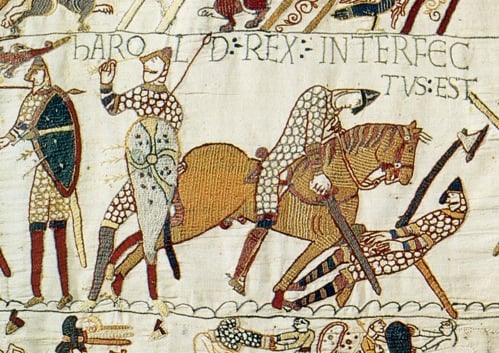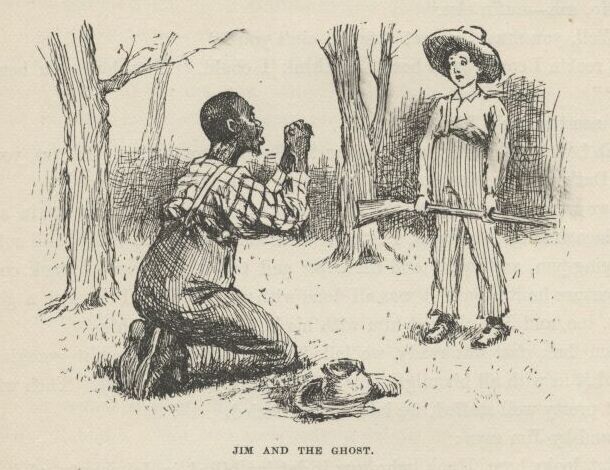From @PhotosOfThePast comes a link to an amazing collection of early photography and pre/proto-photography pictures and tech (like a set of neat pics of a camera obscura kit). Totally worth the time spent browsing. Thanks to Beverly(and her husband) for putting this together.
 The good people at The Register have declared the Bayeux Tapestry one heck of an effective archival medium:
The good people at The Register have declared the Bayeux Tapestry one heck of an effective archival medium:
In the town of Bayeux in northern France you can see the world’s oldest information archive based on a long ribbon of material, a very early example of what was to become tape media…
From the endurance point of view the Tapestry has lasted almost 1000 years – an amazing record. The vegetable dyes used to colour the threads have kept their colour for nearly one hundred decades, and the woven cloth fabric has kept its structural integrity for the same time period despite several instances of mistreatment. Who says ribbons of “TAPEstry” are unreliable?[read full article]
I’ve never thought of the tapestry this way. Mostly, I know it from the opening to Robinhood Prince of Thieves.
Art as a mnemonic recall tool has been used the world over. Anyone familiar with indigenous peoples’ land claim disputes in Canada knows how wampum belts can be used as legal/historical documents.
In a world where so much cultural production is high-tech and/or disposable, history will always provide examples of lower-tech approaches that have an enduring quality.
There are some risks. The Bayeux tapestry requires a mix of other records to survive for us to understand it. A series of floods and fires could have wiped its story off the historical map. Still, it gets points for lasting.
Will today’s digital repositories achieve this sort of longevity? Even in the last 50 years, some digital records has slipped from our grasp because of fast moving technological developments.
The Bayeux Tapestry is a good reminder to keep things simple. It’s also a reminder that archiving information, though a fallible process at the mercy providence, is important in information saturated times such as these.
It’s not about preserving a single item, like the tapestry. It’s important to work to capture the information that makes any single item make sense. This is the ongoing challenge and the wonderful mission of archives.
The Denver Post has put up an impressive set of colour photos from the 30s.
These images, by photographers of the Farm Security Administration/Office of War Information, are some of the only color photographs taken of the effects of the Depression on America’s rural and small town populations. The photographs and captions are the property of the Library of Congress and were included in a 2006 exhibit Bound for Glory: America in Color.[full post]
You can check out the Library of Congress’s digital exhibit here (Requires Silverlight… really? LoC’s going to make me use IE?)
I’m a sucker for old signage, but there’s lot more than that to see here. History buffs should check out the headlines posted in the photo below. It’s upsetting to hear that “Flying Santa Will be Delayed”, but there’s a more interesting one about Italy and Mussolini.
The music world is abuzz with Radiohead talk today… I’m going to pass until I’ve heard the whole album.
But, I did make a couple good addition to my playlists this week.
The Smith Westerns remind me of the Islands in a blender with Blitzen Trapper.
And then… new music from Cut Copy!
These guys are my reigning kings of up-beat retro pop. Sing along, dance along, or just bop your head – you cannot prevent these outcome. Great album art, too.
I don’t know why I haven’t listened to Pet Sounds in so long.
“Wouldn’t It Be Nice” is attached to a handful of good and sort of painful memories, but it is a testament to its enduring amazingness that I’m still singing it (in a bad falsetto) in the shower.
Have a great weekend, everyone.
Some old favourites have been key to my successful work-week’s soundtrack.
Let’s start off with Pulp‘s “This is Hardcore”.
I didn’t like this one when I heard it for the first time, back in like 1999. It’s melodramatic, languid drag grew on me. Now “This is Hardcore” has to be my favourite Pulp song. You have to love the intro dialogue: “Hey, I went to college once. And, all they found were rats in my head.”
And, Sun Kil Moon.
Thoughful, a little mournful and haunting, but sort of expansive – this song is perfect for day-dreaming about solitary road trips down wintry backroads. I’ve enjoyed this band for years, precisely because his songs are so simply and honestly written. Mark Kozelek’s album of Modest Mouse covers is pretty stellar, too.
Have a great Friday afternoon!
NPR, the other day, had an interview with Kenneth Slawenski author of J.D. Salinger: A Life.
From NPR.org:
One revelation that is elaborated on throughout Slawenski’s erratic biography [Stirling says: Ouch.] is just how crucial Salinger’s World War II experiences were to his later Zen Buddhism, as well as to his writing. Salinger served in an Army Counter Intelligence Corps. On D-Day, he landed on Utah Beach, then went on to fight in the Battle of the Bulge; toward the end of the war, he helped liberate a sub-camp of Dachau. According to Slawenski, manuscript pages of The Catcher in the Rye were on Salinger’s person throughout the fighting.[full article with audio!]
Crazy. One stray bullet and no Holden Caulfield! Generations of angst-ridden teens would’ve lost out. After all, there’s no Edward the Sulking Vampire without dear Mr. Caulfield.
Salinger fans would do well to check out Slawenski site: Dead Caulfields.
 Ground breaking computer graphics in your music video are just not enough to make people feel the love anymore.
Ground breaking computer graphics in your music video are just not enough to make people feel the love anymore.
From CBC.ca:
The 1980s song Money for Nothing by the British rock band Dire Straits has been deemed unacceptable for play on Canadian radio.
In a ruling released Wednesday, the Canadian Broadcast Standards Council says the song contravenes the human rights clauses of the Canadian Association of Broadcasters’ Code of Ethics and Equitable Portrayal Code…
Last year, a listener to radio station CHOZ-FM in St. John’s complained that the ’80s rock song includes the word “faggot” in its lyrics and is discriminatory to gays…
A CBSC panel concluded that the word “faggot,” even if once acceptable, has evolved to become unacceptable in most circumstances.
The panel noted that Money for Nothing would be acceptable for broadcast if suitably edited.[source]
Hot on the heels of the muckitymuck about Huck Finn’s vocabulary, Canada finds itself facing a similar (if less literary) debate.

I’m always surprised when the debate over the Adventures of Huckleberry Finn returns. I’m not sure why that is. I shouldn’t be. According to the ALA it is among the top five most challenged books in the United States. The controversy, as we all should know, stems largely from the representations of Jim and the vocabulary attached to him. But don’t worry, someone has come up with a way to solve the problem.
From the New York Times:
Throughout the book — 219 times in all — the word “nigger” is replaced by “slave,” a substitution that was made by NewSouth Books, a publisher based in Alabama, which plans to release the edition in February.
Alan Gribben, a professor of English at Auburn University at Montgomery, approached the publisher with the idea in July. Mr. Gribben said Tuesday that he had been teaching Mark Twainfor decades and always hesitated before reading aloud the common racial epithet, which is used liberally in the book, a reflection of social attitudes in the mid-19th century…
“I’m by no means sanitizing Mark Twain,” Mr. Gribben said. “The sharp social critiques are in there. The humor is intact. I just had the idea to get us away from obsessing about this one word, and just let the stories stand alone.” (The book also substitutes “Indian” for “injun.”) [full article here]
Except that of course he is sanitizing it. Gibben’s scheme to end the book’s contentiousness is an end run around the book itself, a way to make it easier to swallow Twain’s social criticisms. A nice spoonful of sugar.
But, carbo-loading your literature isn’t the best idea. Read the rest of this entry »






